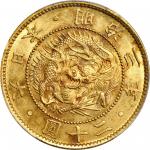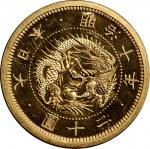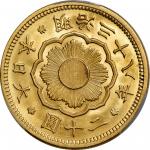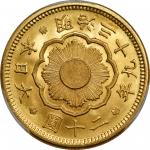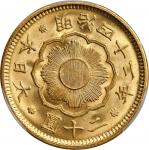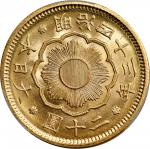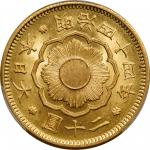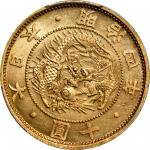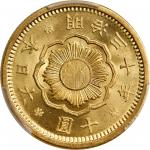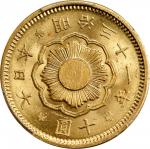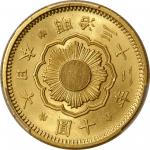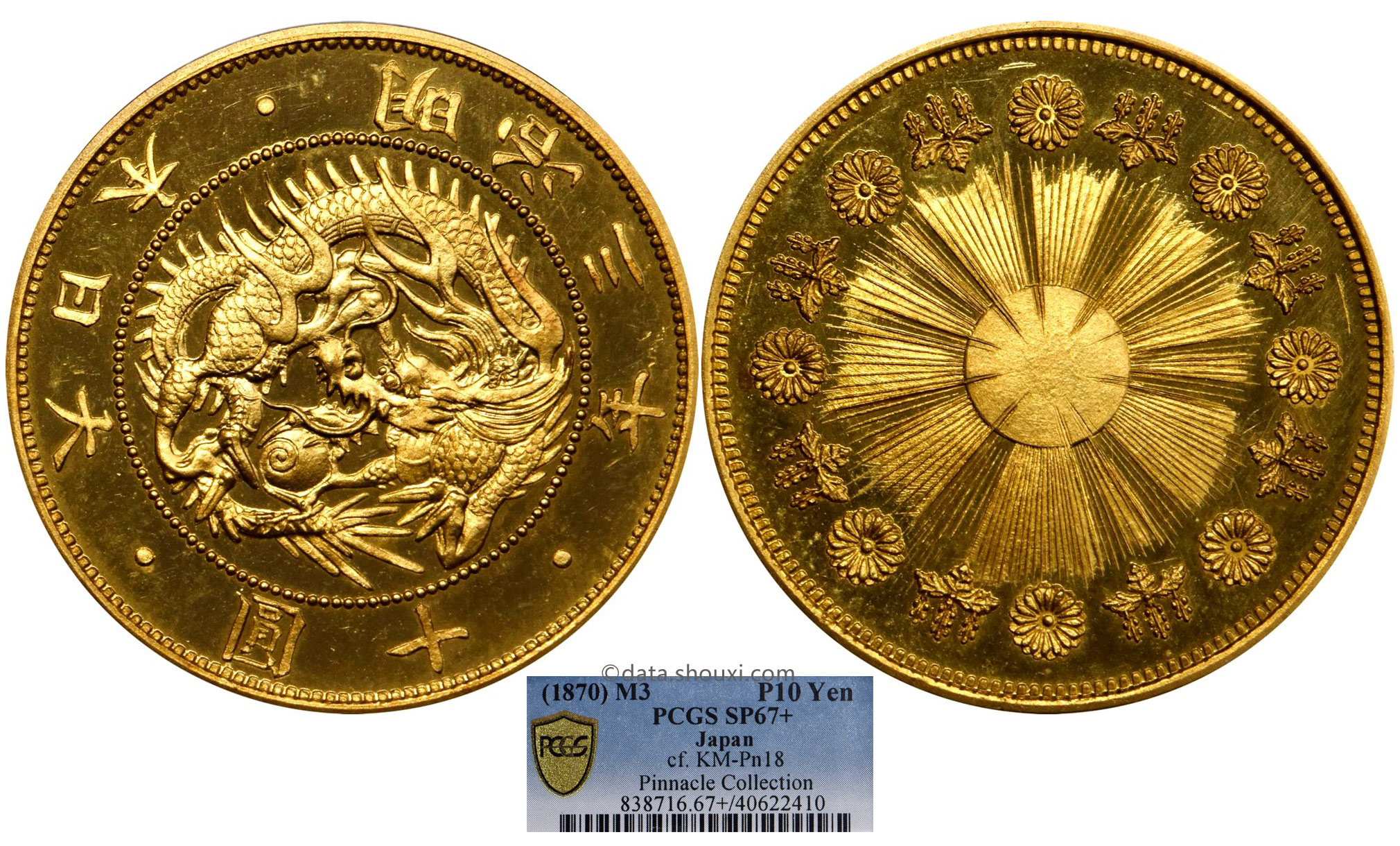日本明治三年样币一组八枚,极具意义日本早期一组样币
已知存世仅两套-博物馆藏外的孤品
国宝
日本明治三年样币。一组八枚。伦敦(英国皇家)造币厂。
1)金十圆。 PCGS SPECIMEN-67 +。 cf. KM-Pn18。
2)金五圆。 PCGS SPECIMEN-67。 KM-Pn18。
3)金二圆半。 PCGS SPECIMEN-67。 KM-Pn17。
4)锡一圆。 PCGS SPECIMEN-65。 KM-Pn16var.
5)锡半圆。 PCGS SPECIMEN-65。 KM-Pn15 var。
(与十圆相同的反面模具所铸)。
6)铜镍四分一圆。 PCGS SPECIMEN-66。 KM-Pn14 var。
7)铜镍十分一圆。 PCGS SPECIMEN-67。 KM-Pn12 var.
8)铜镍二十分一圆。 PCGS SPECIMEN-66。 KM-Pn10 var.
整套:伦纳德-查尔斯-维恩(Leonard Charles Wyon)所铸。正面:龙。反面:旭日光芒,四周交替以菊花和桐花围绕。边缘:光边。完美无瑕的品相,仿如150年前如出新厂。金製的三枚橙金色调璀璨,间有一些淡红色,原味十足。锡製的两枚同样华丽夺目,底板光可鑑人,延展至币缘光泽逐变柔和。铜镍的两枚亮泽如镜,呈现玫瑰色及香槟色,均匀带彩。首屈一指、令人叹为观止的品相,在日本钱币学中亦可说是举世无双之作。
美国海军准将佩里的"砲艇外交",开启了日本与西方文化之间的贸易交流。紧随随后的十年间,日本决定对其造币厂进行现代化改革,并于 1868 年从位于香港的英国造币厂购买了由 James Watt Company 製造的造币机。由于商贸发达、运河充足、交通便利,大坂市自然成为这些新设施的理想据点。
1869 年,以"两"为面额的旧货被摒弃,并根据新创建的日圆採用十进制系统。此外,与以往截然不同的是,新货币将是循环系统。定下基本的架构后,日本开始著手设计新货币。原型由日本的著名金匠加纳夏雄、设计师増田友夫和书法家石井宏香联手筹备。完成后,这些设计随即被送至英国。
按时序推论,这些设计很可能在 1870 年初被送抵伦敦皇家造币厂。著名 Wyon 家族的金匠 Leonard Charles Wyon 立即著手打铸模具。最后,共创建了八种面额的模具:十圆、五圆、二圆半、一圆、半圆、四分一圆、十分一圆及二十分一圆。时至今日,这些模具仍然妥善存放于大英博物馆内。
1870 年 4 月,新任的铸币大师托马斯-威廉-金德(Thomas William Kinder)抵达大坂,普遍认为第一批的试铸币亦是于当时同时出现。确切原因虽无从考究,但最终还是决定重新设计反面图案,著重强调传统性,在所有面额上都添加花环及交叉双旗。此外,对所发行的面额亦有修改,增加了二十圆,而二圆半则变为二圆。同年 11 月,日本安装铸造机,正式开始铸造硬币。新货币时代就此正式开始!
此套试铸套币,不但代表了伦纳德-怀恩(Leonard Wyon)的不懈努力,亦是第一套以西方铸币技术製造的日本钱币。虽然不确定当时试铸的数量,但显然铸额甚少,存世至今的可算是凤毛麟角。实际上,已知的存世样币仅两套。据说其中一套保存于威尔士 Llantrisant 的皇家造币厂博物馆,另一则是在本次拍卖中登场的这套亮点。大英博物馆和日本银行收藏中亦有囊括一些其他金属的试铸。在私人收藏中,试铸一圆偶有出现,但版式绝对是稀少之作。总而言之,此套样币寥若晨星,不但品相风范极致,更是现代日本机铸币的先祖,象徵了该国的现代化进程。真正的国宝,极可能是此后的数个世代间最后一次的公开亮相。
まさに国宝クラス
千載一遇の試鋳貨セット
現存2組のみ存在するも、民間では唯一の入手可能品
明治3年試作貨(8枚セット)
1) 十円試鋳金貨。 PCGS SPECIMEN-67+. cf. KM-Pn18.
2) 五円試鋳金貨 PCGS SPECIMEN-67. KM-Pn18.
3)二円半試鋳金貨。 PCGS SPECIMEN-67. KM-Pn17.
4) 一円試鋳錫貨。 PCGS SPECIMEN-65. KM-Pn16 var.
5)半円錫打試鋳貨。 PCGS SPECIMEN-65. KM-Pn15 var. (10円と同じ裏面のダイで鋳造).
6) 4分1円白銅打試鋳貨。 PCGS SPECIMEN-66. KM-Pn14 var.
7) 10分1円白銅打試鋳貨。 PCGS SPECIMEN-67. KM-Pn12 var.
8) 20分1円白銅打試鋳貨。PCGS SPECIMEN-66. KM-Pn10 var.
作:Leonard Charles Wyon
表側:竜図
裏側:旭日図
エッジ:プレーンエッジ
150年以上前に鋳造された状態とほぼ同じ完璧な保存状態のセット。3つの金貨は鮮やかなオレンジゴールドの色調を備え、やや明るい赤みも現れている。ほぼオリジナルの状態であるといえます。1円と半円は錫打ちですが明るい光沢がしっかりと残っており、縁に沿って落ち着いた古色を見せています。3つの白銅打貨は光を反射してローズもしくはシャンパンゴールドの色調で光彩を放っています。セット全体を通して目を見張るような外観を備えており、日本の貨幣学において比類なき美しいセットといえるでしょう。
ペリー提督の「砲艦外交」が日本と西洋文化の貿易の開放につながった後の10年間、日本は1868年に香港のイギリスの造幣局からジェームズ・ワット・カンパニー製の機器を購入し、鋳造施設を近代化することを決意しました。整備された運河という交通のアドバンテージが重要視された結果、新しい造幣施設にとって理想的な場所は大阪であると判断されました。つづいて1869年、両を基準とした通貨システムを破棄し、新しく作成された円に基づく10進数の貨幣制度を採用することが決定されました。さらに、これまでの貨幣と異なり、新しい通貨は世界基準を見据えた円形で揃えることが決定されました。これらの決定の上、新しい通貨を設計する大計画が始まりました。オリジナルのプロトタイプは、日本の金工師である巨匠・加納夏雄氏が、デザインを手がけた増田友夫氏と書記家であった石井宏香氏と共同で制作しました。完成後、デザインはイギリスに送られました。
そして、1870年の頭にロンドンの王立造幣局の手に渡ったとされています。有名なWyon家の彫刻家Leonard Charles Wyonはすぐに新しい貨幣のため、ダイの準備に取り掛かりました。合計で、10円、5円、2円半、1円、半円、4分1円、10分1円、20分1円の8種類のダイが作成されました。現在、これらのダイは大英博物館に保存されています。
1870年4月までに、新設の造幣長官Thomas William Kinder が大阪に到着し、最初のパターンも同時に来日したと考えられています。理由は不明なままですが、最終的には裏面に再設計を施し、すべての額面に菊の紋と錦の御旗を付け、より伝統的なデザインが採用されました。額面も修正が加えられ、20円が追加、2円半は2円となり、小貨の「銭」と「厘」も作成されました。同年11月までに鋳造機械が設置され、日本は正式にコインを鋳造し始めました。 まさに新しい時代の幕開けでした!
今回のパターンセットは、Leonard Wyonの努力の結晶であり、西洋の手段で製造された最初の日本の硬貨と見なすのが妥当です。最初に作られたコインの数は不明ですが、今日ではすべて大珍品であり、発行枚数・現存枚数共に極少であることは明らかです。古今東西見回しても2セットしか存在の確認が取れていません。1つは、今日ウェールズのラントリサントにあるロイヤルミント博物館にあると言われています。そして残るもう1つはこのセットです。また、大英博物館と日本銀行のコレクションには、他の金属で鋳造された単品であればいくつかは存在するようです。一般市場に於いては、円であればまれに現れますが、それでも大珍品です。つまりどういうことかというと、このセットは個人コレクションに所蔵されるのであれば、唯一のチャンスということです。
本品は日本の貨幣歴史の中、最も羨望の的となるアイテムの1つといえます。希少であるだけでなく、近代日本の歴史的貨幣であり、西洋に開放されて以後の日本の進歩と前進の象徴として存在しています。真の国宝であり、これからのち多くの世代にとってはこれにて最後のお目見えとなるでしょう。
Monumentally Important Early Japanese Pattern Set
One of Two Complete Sets Known - Unique Outside of a Museum
A National Treasure
JAPAN. Pattern Set, Year 3 (1870). London (British Royal) Mint. Mutsuhito (Meiji). All PCGS Gold Shield Certified.
1) Gold 10 Yen. PCGS SPECIMEN-67+. cf. KM-Pn18.
2) Gold 5 Yen. PCGS SPECIMEN-67. KM-Pn18.
3) Gold 2-1/2 Yen. PCGS SPECIMEN-67. KM-Pn17.
4) Tin Yen. PCGS SPECIMEN-65. KM-Pn16 var.
5) Tin 1/2 Yen. PCGS SPECIMEN-65. KM-Pn15 var. (struck with same reverse die as 10 Yen).
6) Copper-Nickel 1/4 Yen. PCGS SPECIMEN-66. KM-Pn14 var.
7) Copper-Nickel 1/10 Yen. PCGS SPECIMEN-67. KM-Pn12 var.
8) Copper-Nickel 1/20 Yen. PCGS SPECIMEN-66. KM-Pn10 var.
All: By Leonard Charles Wyon. Obverse: Dragon. Reverse: Sunburst surrounded by alternating chrysanthemums and paulownia. Edge: Plain. A immaculate quality set which remains in nearly the same condition that it was struck just over 150 years ago. The three gold denominations now display vibrant orange-gold tone with a few reddish toning blushes that attest to their originality. The Yen and 1/2 Yen, produced in tin, are similarly fresh, with surprisingly luminous fields and only a few areas along the edges where the metal has subdued. Similar to the larger dominations, those struck in copper-nickel alloy display strong reflective qualities in fields, with each coin displaying tone that ranges from rose to champagne. Together, the appearance is absolutely breathtaking, and is of unsurpassed beauty in Japanese numismatics.
In the decade following the "Gunboat Diplomacy" of United States' Commodore Perry which led to the opening up of trade between the Japan and western culture, Japan decided to modernize its minting facilities, purchasing equipment in 1868 from the British mint in Hong Kong that was made by the James Watt Company. It was decided that Osaka would be an ideal location for these new facilities, as the city was well-developed with ample canals to ease transport.
In 1869, the decision was made to discard the old currency system with its Ryo-based denominations, and adopt a decimal system based off the newly-created Yen. Further, it was decided that unlike in the old system, the new currency would be circular. With these decisions made, the process of designing the country's new currency began. Original prototypes were produced by Japan's master engraver, Natsuo Kano, in conjunction with Tomoo Masuda, who worked on design, and Hyoka Ishii, who was the calligrapher. Once finished, these designs were sent to England.
The designs likely made their way into the hands of the Royal Mint in London in early 1870. Engraver Leonard Charles Wyon, of the famous Wyon family, quickly went to work, preparing dies for the new coinage. In total, dies for eight denominations were created: 10 Yen, 5 Yen, 2-1/2 Yen, 1 Yen, 1/2 Yen, 1/4 Yen, 1/10th Yen and 1/20th Yen. Today, these dies still exist, and are cared for by the British Museum.
By April 1870, the newly established mintmaster Thomas William Kinder had arrived in Osaka, and it is thought that the first patterns arrived concurrently. While the reasoning remains unclear, the decision was ultimately made to redesign the reverses, making them appear more traditional, with a wreath on all denominations and flanking flags on the gold. The denominations that were to be produced were also amended, with the 20 Yen added and the 2-1/2 Yen becoming a 2 Yen. By November of that year, the minting machinery had been installed, and Japan officially began striking coins. A new era had begun!
Regarding the patterns offered here, they represent the efforts of Leonard Wyon, and it's fair to consider them the first set of Japanese coins manufactured by western means. While it's uncertain how many coins were originally made, it is clear that the number was few, as all are EXCESSIVELY RARE today. In fact, only two intact sets are known to survive. One is said to reside in the Royal Mint Museum, which is located today in Llantrisant, Wales. The other is this set. It's also worth noting that a handful of singles and strikings in other metals appear in the British Museum and Bank of Japan Collection; in private hands, the Yen appears from time to time, but appearances are certainly rare. In summery, this set appears entirely unique, and unduplicatable in private hands. As such, it represents one of, if not the most desirable items that emanates from Japan's numismatic history -- as not only is its rarity unsurpassed, but it is the patriarch of modern Japanese coinage, and it stands as a symbol for the country's progress and path forward since opening to the West. A true national treasure, its offering here may well represent the last appearance for many generations to come.
Estimate: $750,000 - $1,500,000.
Provenance: From the Pinnacle Collection.
Ex: Hess-Divo (4/1999) Lot # 1.

